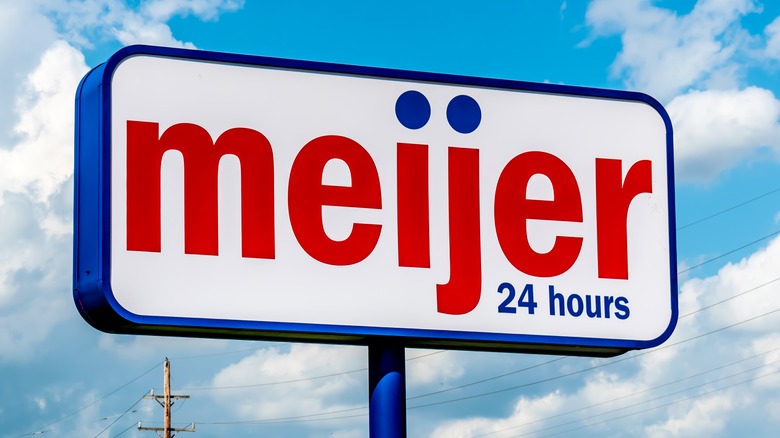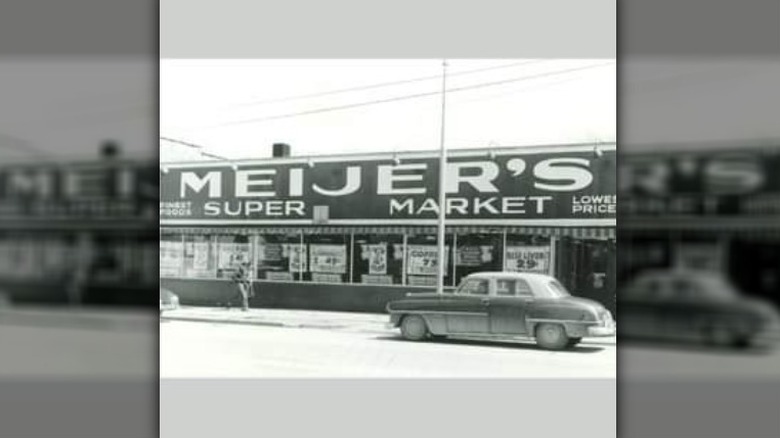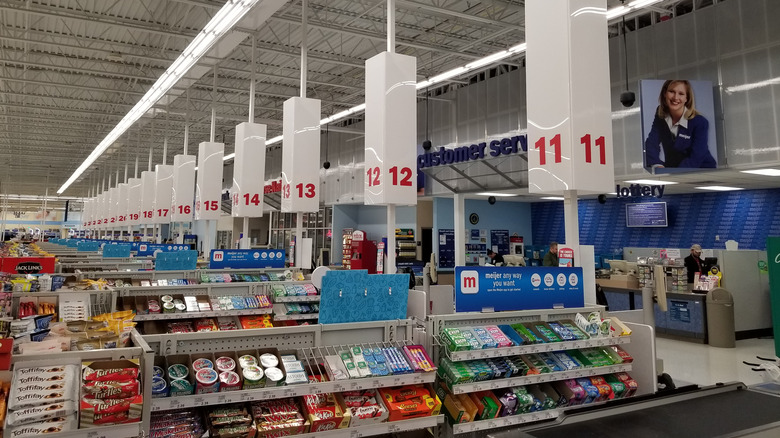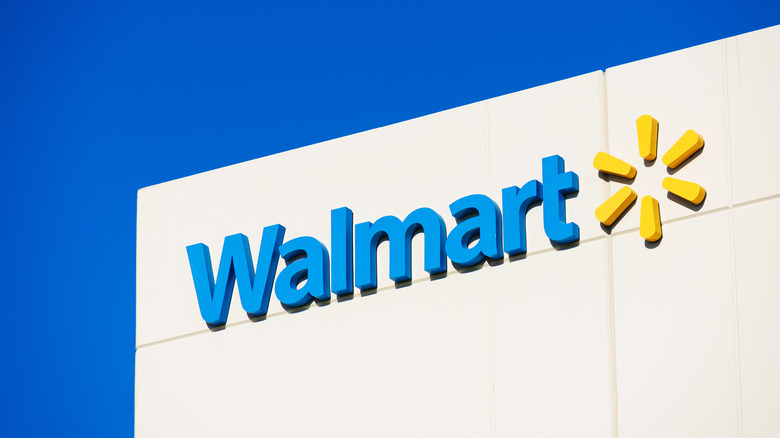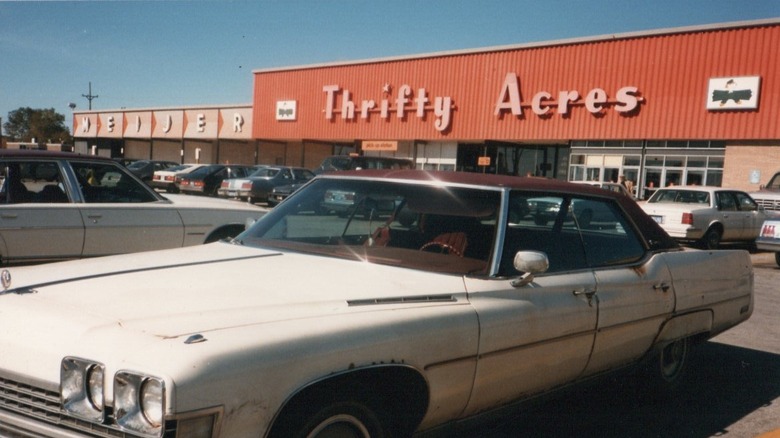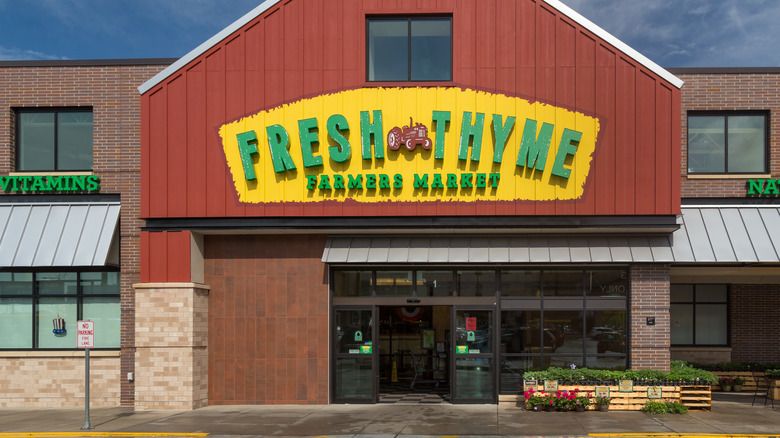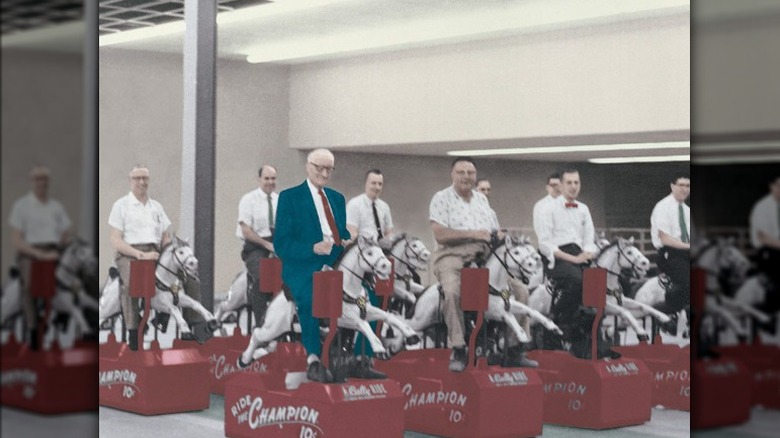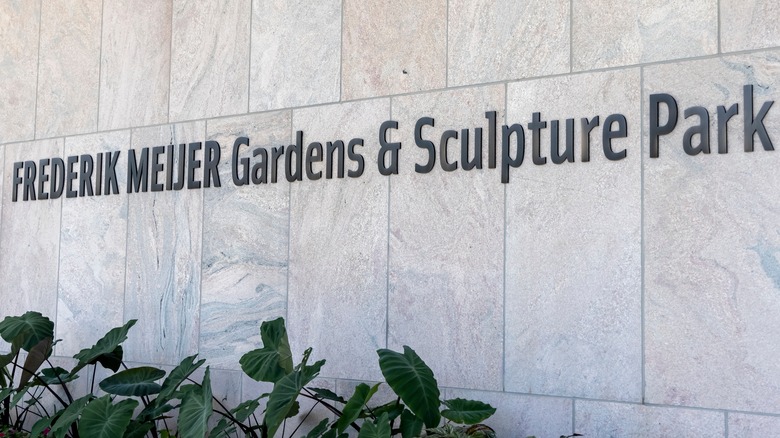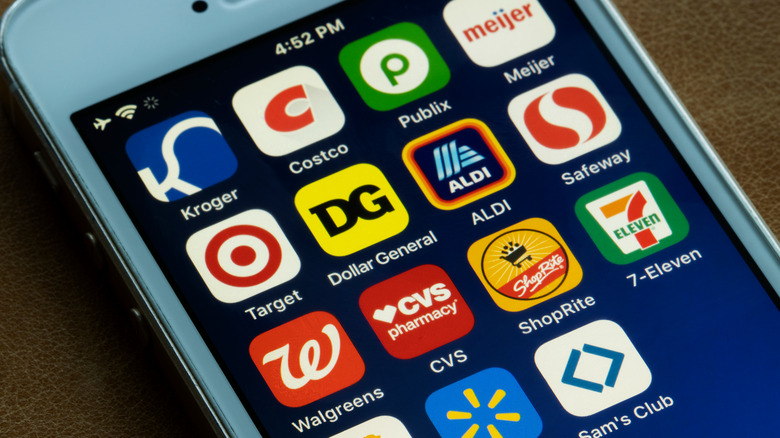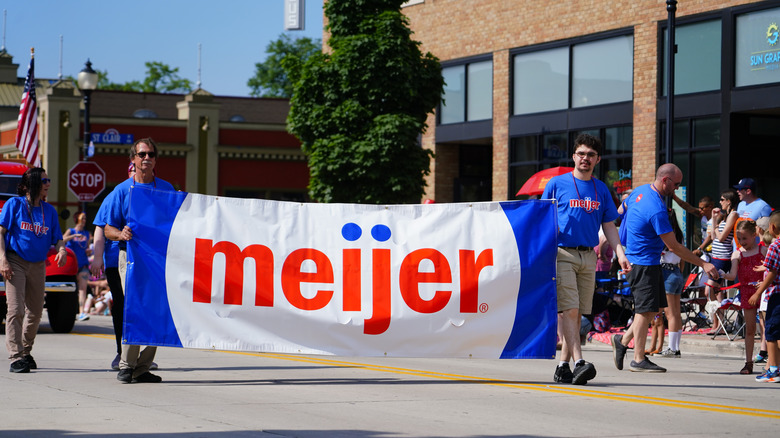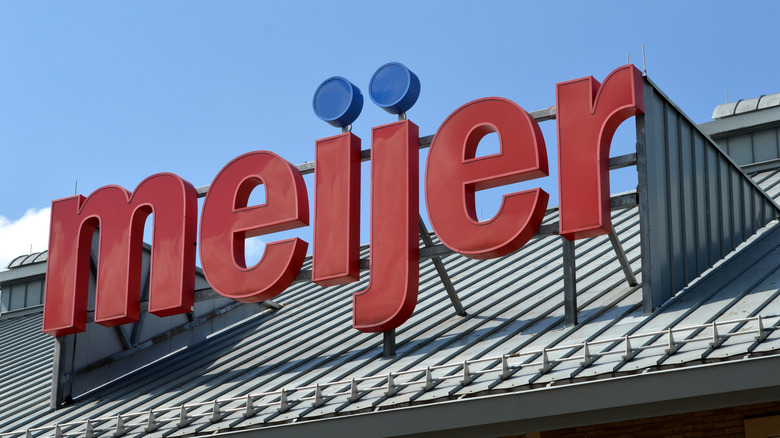The Untold Truth Of Meijer
Those who live in the Midwest likely already know (and love) Meijer. This grocery store chain dominates mid-size cities with its wide array of products at affordable prices. According to the brand, each store offers more than 220,000 products, from groceries to sporting goods, and among those items are more than 600 varieties of produce (the produce is important, but more on that later). Some might be tempted to liken Meijer to Walmart, but don't make that mistake. Meijer fans will vehemently claim the regional superstore is superior to the global behemoth and for good reason: Meijer laid the groundwork for Walmart. Meijer walked in the Great Depression so Walmart could run in the latter half of the century.
Yes, a lot of secrets and interesting fun facts lie behind the minimalistic red and blue Meijer logo, and we're about to share them all. Here's the untold truth of Meijer.
The first Meijer opened in 1934
Hendrik Meijer opened his first store in 1934, but that store wasn't the same as the one Meijer shoppers will see today. Meijer's Grocery, as it was called, opened in the middle of the Great Depression in Greenville, Michigan (the chain's headquarters is still in Grand Rapids, Michigan, today). Originally a barber and a Dutch immigrant, Meijer opened Meijer's Grocery as an extra benefit to his barbershop clientele. He started out with just $338.76 worth of inventory, all purchased on credit, but with the help of his son Fred and daughter Johanna, the concept became a success, and less than a decade later, in 1941, he opened a second store. Four more stores followed in the 1950s and, by the 1960s, there were more than a dozen Meijer's Grocery stores across the Grand Rapids region.
Why was the Meijer family so successful in the grocery business? Part of their success could be credited to their forward-thinking modernization attempts.
Meijer has always been at the forefront of innovation
If you think self-checkout or ordering your groceries for pick-up via an app is innovative, you should've watched the evolution of grocery shopping under Hendrik Meijer. From nearly the very beginning, Meijer invested in the latest and greatest grocery-shopping tech. In 1938, the brand added its first shopping carts to its stores. In 1941, when the second Meijer store opened, daughter Johanna was at the helm, an almost unheard-of position for women at the time; however, by 1945, half of all Meijer positions were taken by women. In 1954, Meijer introduced its automatic conveyer belts in the checkout lane, around the same time it started advertising on television (via Companies History).
In the latter half of the century, Meijer continued to innovate. In the 1970s, it added checkout scanners to complement those nifty automatic conveyor belts. In the 1980s, it introduced the concept of a 24-hour grocery store. In the 1990s, it launched the Meijer website.
Meijer inspired Walmart in 1962
While Walmart is admittedly more well-known than Meijer today, Meijer actually provided the inspiration Sam Walton needed to launch his initial venture. In 1962, Meijer opened the first American "hypermarket," a concept that was already popular in Belgium, but that had yet to reach U.S. shores. The hypermarket was a newfangled idea that allowed shoppers to buy everything they needed in one spot — groceries, home goods, clothes, and all the rest. Meijer named the first American superstore Thrifty Acres and its slogan was "a self-service discount department store with the hometown touch" (via the Detroit Free Press). It offered 18 checkout lanes and 7 acres of parking.
According to the Michigan Historical Center, which erected a historical marker at the existing Meijer store on the same plot in 2015 (the name was changed from Thrifty Acres to just Meijer in the 1980s), "It really was a new business model. Even the founder of Walmart cites them as an example of who they were looking at when they were inventing their business model. ... Today, they're everywhere, but when they made that big change, they really were changing how we shop today."
Once Walmart came along, following this model, it had its critics, and one of the loudest criticisms? That Walmart's produce simply wasn't as good as what Meijer offered.
Thrifty Acres wasn't the only Meijer spin-off
While Thrifty Acres was the Meijer's Grocery spin-off that stuck, there were other retail concepts the brand launched and abandoned over its history. As Zippia details, Meijer launched a discount pharmacy chain, Spaar, in 1980. Spaar locations went in former Meijer locales before the brand was sold to Perry Drug Stores just a few years later. In 1981, Meijer launched Meijer Square, a discount department store that offered all of the non-food items that a Thrifty Acres might, without any of the groceries. Sagebrush, Copper Rivet, and Tansy were all brands that received even less notoriety; they were all three specialty clothing stores, selling casual wear, Levi's, and women's clothing, respectively. They were sold or closed by the end of the 1980s, though Sagebrush did manage to grow to more than 70 locations before its end. Finally, in the early 1990s, Meijer opened SourceClub, which was its version of a Sam's Club or Costco.
Meijer's most recent spin-off launched in the 2010s
However, even after these decades of unsuccessfully attempted spin-offs, Meijer hasn't completely ceased its foray into other endeavors. In the 2010s, it broached the high-end grocery market with Fresh Thyme (via Michigan Radio), which an investigative reporter found that Meijer started "from the ground up." However, as of 2020, Fresh Thyme was described as being "partially backed" by Meijer. At the time, Fresh Thyme had roughly 75 stores in Illinois, Indiana, Iowa, Kentucky, Michigan, Minnesota, Missouri, Nebraska, Ohio, Pennsylvania, and Wisconsin.
Fresh Thyme combines the savings and value of a traditional Meijer store, with the all-natural, organic appeal of a health food store. On the brand's website, it calls itself a "farmer's market grocery concept." It also compares itself to Whole Foods, thanks to its organic, natural, and gluten-free selections. Additionally, news coverage has called Fresh Thyme a "Whole Foods-Trader Joe's hybrid, seeded with Meijer money." Whatever you want to call it, though, or however you want to describe it, one thing is clear: Fresh Thyme is doing a lot better than Meijer's other spin-offs have historically.
You'll still find coin-operated pony rides in each Meijer store
If you've ever been to a Meijer store, you may have glimpsed a coin-operated pony ride near the checkout lanes. Each Meijer store has the same pony ride (via 99.1 WFMK). However, this isn't just some random occurrence. There's a reason. Frederik Meijer, son of Hendrik, added the pony rides to the stores after he found the original pony, with "10 cents" painted on her side. He thought that a dime was a little too pricey for his client base, so he lowered the cost to one penny and stuck the pony in his store.
Each coin-operated pony is named Sandy. Sandy made that first appearance in 1962 and, since then, she's always cost just one penny per ride, still today. Unfortunately, if you show up for a ride on Sandy, you might be disappointed. According to one Meijer employee AMA on Reddit, Sandy "would be broken for months and they would finally just send us a new one and then that one would break in a couple weeks. I never saw them collect the pennies but I assume they just added it in the cash office."
Meijer offers free prescriptions
We know, we know. In this day and age, it sounds like a hoax. Free prescriptions? In America? Someone's going to give you health care for free? What nonsense! But, yes, Meijer offers free prescriptions via its select free prescriptions program. On the program webpage, the brand details how health care costs have a big impact on families across the Midwest and, so, Meijer offers free prescriptions (with limitations) regardless of a customer's insurance or co-pay. The program will give you, primarily, free select antibiotics and free prenatal vitamins, with a few exceptions. All you need for either is a doctor's prescription and to show up in person to pick up your items.
In 2019, Meijer reached a milestone of having given out 50 million prescriptions through the program since its start in 2006, which saved customers more than $650 million in health care costs. Unfortunately, in 2020, Meijer did make a few changes to its free prescription program, dropping two medications from the list of covered prescriptions: Metformin, for Type 2 diabetes, and generic Lipitor, for cholesterol (via the Detroit Free Press).
Your Meijer steal may be out of date
If you got a great deal on an item at Meijer, you may want to check that best-by date. Meijer has a specific mark-down system for its aging items, according to a former employee on Reddit. While nothing specifically out-of-date is sold under the system, the former employee did note that anything close to its expiration date is discounted. Grocery items are discounted by 50% if they expire within the next month. Ink cartridges and health and beauty items are discounted by 25% if they expire within the next three months, 50% if they expire within the next two months, or 75% if they expire in less than a month.
So, in other words, before you take advantage of what looks like a stellar deal, check your item's best-by date. You might find that the multivitamins that you want to last you for the next three months actually expire within the next few weeks.
The Meijer family continues to recognize its Dutch roots
As mentioned, Hendrik Meijer, the man who started it all, was a Dutch immigrant. Today, the Meijer family, now in its third generation of Meijer leadership, still recognizes their Dutch heritage. Frederik Meijer, for example, established the Frederik Meijer Chair in Dutch Language and Culture at Calvin University in 2006 to support Dutch history education, including the aspects of Netherlandic culture that have played a role in the Meijer brand's success, such as innovation, technology, and economic stability. Frederik Meijer himself is called an "avid student of Dutch history" and a frequent visitor to the Netherlands.
In addition to establishing the Frederik Meijer Chair in Dutch Language and Culture, Frederik and his wife (who worked at the original Meijer grocery store as a cashier) have established a range of other initiatives and organizations to help the Grand Rapids area, such as the Fred and Lena Meijer Heart Center and the Frederik Meijer Gardens & Sculpture Park.
Meijer continues to innovate with the latest tech
The Meijer brand's innovation efforts didn't stop with its fancy website in the 1990s. As recently as the last few years, the brand has continued to innovate, providing customers with the convenience they crave via their favorite tech.
In 2008, Meijer introduced a "shop and scan" program that allowed users to scan bar codes as they shopped and then bag their groceries at the same time. The shop and scan capabilities are available through the Meijer mPerks app. After shoppers complete their shopping and bagging, they just scan a QR code at self-checkout stations and then pay.
Later, in 2014, as Business Insider reports, Meijer became the first retailer to accept both Apple Pay and CurrentC. Business Insider called the decision "noteworthy," as CurrentC had decided to fine users who also accepted Apple Pay, forcing retailers to accept one or the other versus both. However, we see how that ended up; today, CurrentC has become more or less a thing of the past, while Apple Pay remains strong.
Meijer was found lacking for its treatment of LGBTQ employees
For all its modern appeal, Meijer was found stuck in the dark ages in one key area. As The Motley Fool reports, in 2017, according to the Human Rights Campaign Foundation's Corporate Equality Index, which measures how corporations in America treat gay, lesbian, bisexual, and transgender individuals, Meijer earned a 0 rating, meaning that Meijer did not "take any positive steps toward [LGBTQ] employees." The only other two corporations in the country to earn a 0 rating that year were ExxonMobile and Perot Systems.
The index looks at how companies not only treat employees, but also consumers and investors, looking at aspects such as health insurance, retirement benefits, diversity training, job protection, and more. In comparison to Meijer's rock-bottom score, Walmart scored a 40. Companies that earned 100s on the index that year included Xerox, Cisco Systems, and Sun Microsystems. At that time, researchers said the index was particularly meaningful, as the gay and lesbian population in the country was around 15 million, and that population boasted a purchasing power of $650 billion-plus.
Meijer turned things around
Meijer wasn't a brand to let a subpar performance keep it down. In 2020, Meijer pulled through with a 100 rating on the Human Rights Campaign Foundation's Corporate Equality Index and was named one of the best places to work for LGBTQ equality. Meijer proudly touted that it now offered equal employment opportunities to all sexual orientations and gender identities, transgender-inclusive health care, sponsorship of Pride events, partnerships with related nonprofits, and a supportive LGBTQ team member environment via a Meijer Pride resource group.
So how does Meijer rank in 2022? According to the Human Rights Campaign Foundation's latest Corporate Equality Index, Meijer ranked a 100 score for the third year in a row. Today, in addition to all of the offerings mentioned above, Meijer also now provides diversity and inclusion training to all team members. The brand was also once again named a Best Places to Work for LGBTQ+ Equality in 2022.
Meijer has big goals for reducing its carbon emissions
Environmental friendliness is becoming more of an issue for brands around the country and Meijer is among them. In early 2022, Meijer announced a goal to reduce absolute carbon emissions by 50% by 2025. How did the brand plan on meeting this audacious goal? It planned to add renewable energy procurement technologies to its operations, such as new refrigeration methods. It also committed to constructing environmentally-responsible buildings and announced a renewable solar project. The impact of this switch to clean energy aimed to remove an amount of greenhouse gases and carbon emissions from the atmosphere equal to that of 20,000 automobiles on the road, and do the work of approximately 125,000 acres of forestland.
So, how did it go? Fantastically, as it turns out. In fact, Meijer did so well, it reached the goal in 2024 — a full year early.
Meijer today
Today, the Meijer brand is led by the grandsons of Hendrik Meijer, Hank and Doug Meijer. The two share ownership and are worth $16.7 billion, according to Forbes. Both in their 60s, they took over for Frederik Meijer in 1990, though they only served as co-CEOS through 2017. Now, they sit on the board and let Rick Keyes do all the CEO work. Keyes was the very first non-Meijer family CEO to lead the brand.
Meijer now boasts more than 250 superstores throughout Michigan, Ohio, Indiana, Illinois, Kentucky, and Wisconsin, with more than 70,000 total team members. Meijer stores continue to offer the latest tech, from the more recent shop and scan program to home delivery and pickup. The in-store pharmacy still offers those free prescriptions and the brand still prides itself on its wide array of high-quality produce that made it stand apart (and still makes it stand apart!) from Walmart in the 1960s.
